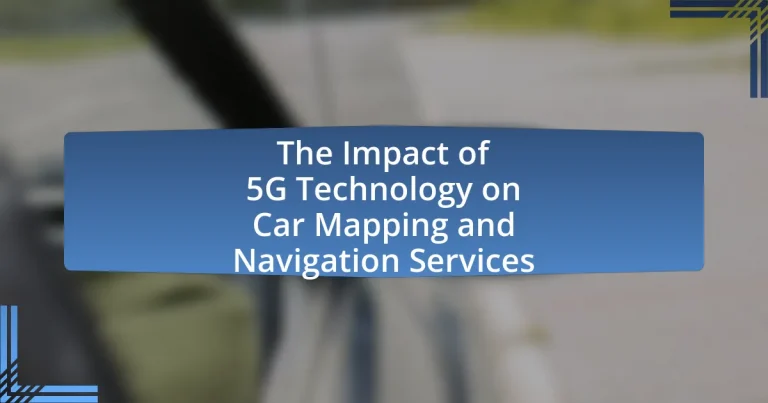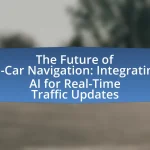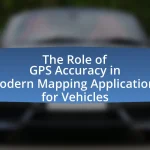The article examines the impact of 5G technology on car mapping and navigation services, highlighting its role in enhancing data transmission speeds, reducing latency, and improving connectivity. Key features of 5G, such as high bandwidth and low latency, facilitate real-time data processing, leading to more accurate navigation and traffic management. The article also discusses the implications of 5G for vehicle-to-everything (V2X) communication, the development of autonomous vehicles, and the integration of artificial intelligence in navigation systems. Additionally, it addresses challenges related to infrastructure, data security, and interoperability that may arise with the implementation of 5G technology in this sector.
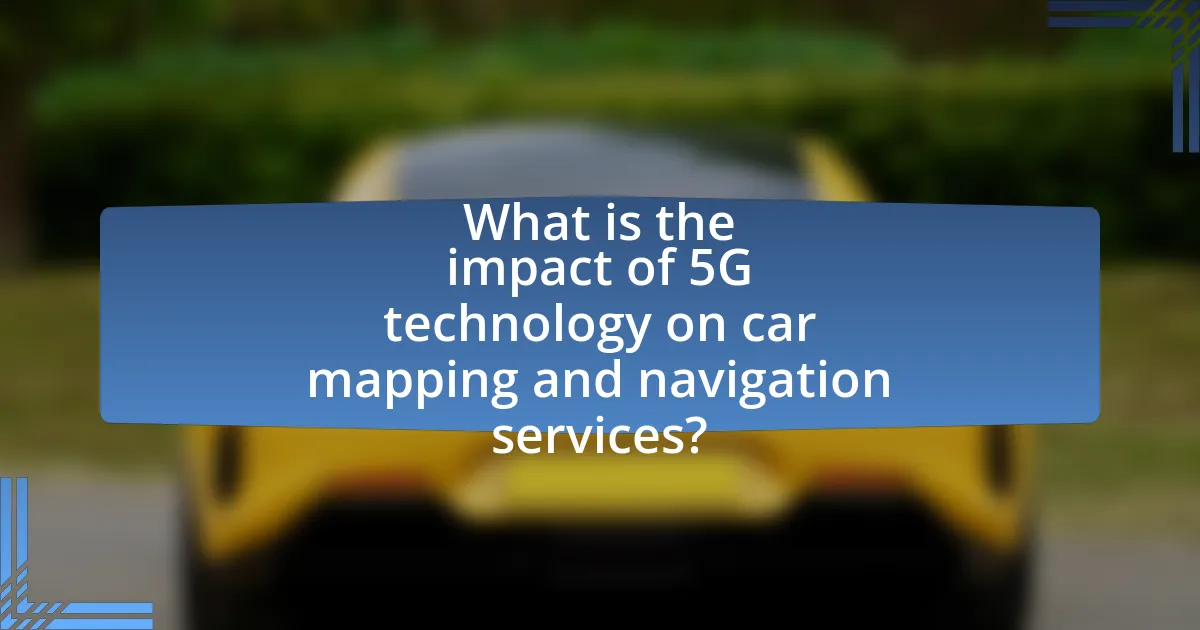
What is the impact of 5G technology on car mapping and navigation services?
5G technology significantly enhances car mapping and navigation services by providing faster data transmission, lower latency, and improved connectivity. This advancement allows for real-time updates and more accurate location tracking, which is crucial for navigation systems that rely on dynamic data such as traffic conditions and road changes. For instance, 5G can support high-definition mapping and enable vehicle-to-everything (V2X) communication, facilitating safer and more efficient driving experiences. Studies indicate that 5G networks can reduce latency to as low as 1 millisecond, compared to 4G’s 30-50 milliseconds, thereby improving the responsiveness of navigation applications.
How does 5G technology enhance real-time data processing in navigation systems?
5G technology enhances real-time data processing in navigation systems by providing significantly higher data transfer speeds and lower latency compared to previous generations. This allows navigation systems to process and analyze vast amounts of data from various sources, such as GPS, sensors, and cloud services, in near real-time. For instance, 5G networks can achieve speeds up to 10 Gbps and latency as low as 1 millisecond, enabling instant updates on traffic conditions, route changes, and environmental factors. This rapid data exchange improves the accuracy and responsiveness of navigation systems, facilitating safer and more efficient driving experiences.
What are the key features of 5G that contribute to improved navigation accuracy?
The key features of 5G that contribute to improved navigation accuracy include enhanced bandwidth, low latency, and increased device density. Enhanced bandwidth allows for the transmission of larger amounts of data, which facilitates real-time updates and more precise location information. Low latency, with response times as low as one millisecond, enables quicker communication between devices and servers, ensuring that navigation systems can react instantly to changes in the environment. Increased device density supports a higher number of connected devices in a given area, improving the accuracy of location data through better triangulation and signal strength. These features collectively enhance the reliability and precision of navigation services, making them more effective for users.
How does low latency in 5G affect user experience in car navigation?
Low latency in 5G significantly enhances user experience in car navigation by enabling real-time data processing and communication. This rapid response time allows for instantaneous updates on traffic conditions, route changes, and hazard alerts, which are crucial for safe and efficient navigation. For instance, 5G networks can reduce latency to as low as 1 millisecond, compared to 4G’s average of 30-50 milliseconds, facilitating quicker decision-making for drivers. This improvement leads to more accurate navigation instructions and timely rerouting, ultimately resulting in a smoother and more reliable driving experience.
What are the potential benefits of 5G for car mapping services?
5G technology offers significant benefits for car mapping services, primarily through enhanced data transmission speeds and reduced latency. These improvements enable real-time updates and more accurate mapping data, which are crucial for navigation systems. For instance, 5G can support high-definition maps that require frequent updates, allowing vehicles to receive instant information about road conditions, traffic, and obstacles. Additionally, the increased bandwidth of 5G facilitates the integration of advanced features such as augmented reality navigation, which enhances the driving experience by overlaying digital information onto the real world. The ability to connect multiple devices simultaneously without degradation in performance also supports vehicle-to-everything (V2X) communication, improving safety and efficiency in navigation.
How can 5G improve traffic management and route optimization?
5G can improve traffic management and route optimization by enabling real-time data transmission and communication between vehicles and infrastructure. This enhanced connectivity allows for the collection and analysis of vast amounts of traffic data, leading to more accurate traffic predictions and dynamic routing. For instance, 5G’s low latency facilitates immediate updates on traffic conditions, accidents, and road closures, allowing navigation systems to adjust routes in real-time. Studies indicate that cities implementing 5G technology have seen reductions in traffic congestion by up to 30%, demonstrating its effectiveness in optimizing traffic flow and improving overall transportation efficiency.
What advantages does 5G offer for vehicle-to-everything (V2X) communication?
5G offers significant advantages for vehicle-to-everything (V2X) communication, primarily through enhanced speed, reduced latency, and increased connectivity. The high data transfer rates of 5G, reaching up to 10 Gbps, enable real-time communication between vehicles and infrastructure, which is crucial for applications like collision avoidance and traffic management. Additionally, 5G’s latency can be as low as 1 millisecond, allowing for instantaneous responses in critical situations, thereby improving safety and efficiency on the roads. Furthermore, 5G supports a massive number of connected devices per square kilometer, facilitating a more robust network for smart transportation systems. These features collectively enhance the reliability and effectiveness of V2X communication, making it a cornerstone for future smart mobility solutions.
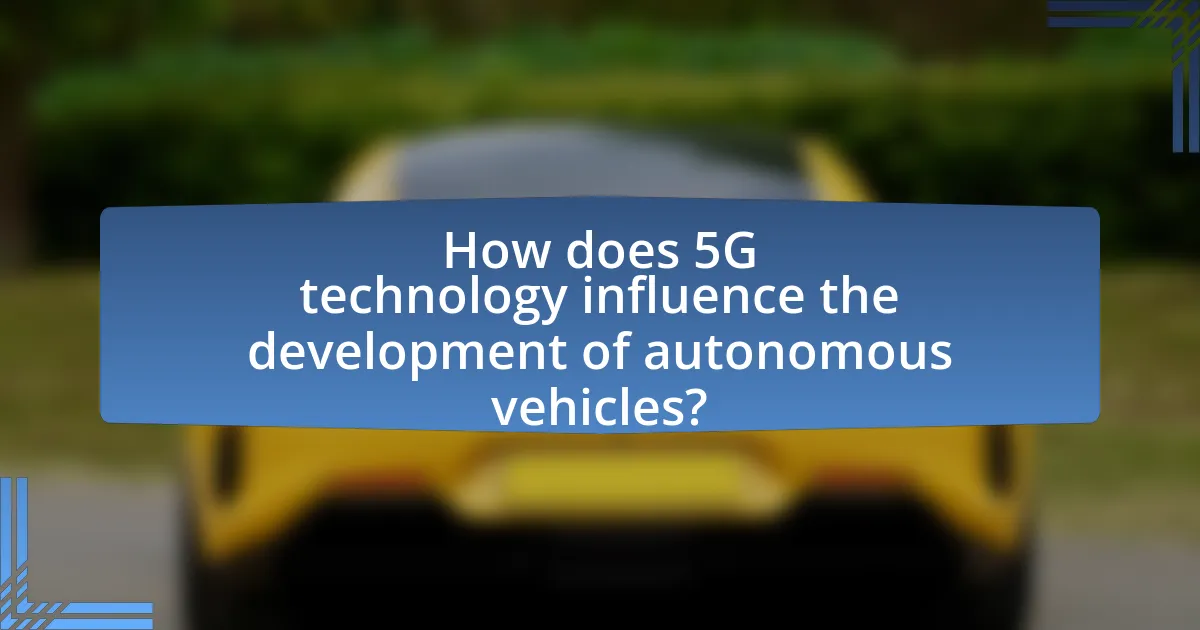
How does 5G technology influence the development of autonomous vehicles?
5G technology significantly enhances the development of autonomous vehicles by providing ultra-reliable low-latency communication, which is crucial for real-time data exchange. This capability allows autonomous vehicles to process vast amounts of information from various sources, such as sensors, cameras, and other vehicles, with minimal delay. For instance, 5G networks can support vehicle-to-everything (V2X) communication, enabling vehicles to communicate with infrastructure, pedestrians, and other vehicles, thereby improving safety and efficiency. According to a study by the International Telecommunication Union, 5G can reduce latency to as low as 1 millisecond, which is essential for the rapid decision-making required in autonomous driving scenarios. This technological advancement facilitates better mapping and navigation services, allowing for more accurate and timely updates to vehicle positioning and route optimization.
What role does 5G play in the connectivity of autonomous vehicles?
5G plays a crucial role in the connectivity of autonomous vehicles by providing high-speed, low-latency communication essential for real-time data exchange. This advanced connectivity enables autonomous vehicles to process vast amounts of information from various sources, such as traffic signals, road conditions, and other vehicles, facilitating safer and more efficient navigation. For instance, 5G networks can support data transfer rates exceeding 10 Gbps and latency as low as 1 millisecond, which are critical for the rapid decision-making required in autonomous driving scenarios. This capability enhances vehicle-to-everything (V2X) communication, allowing vehicles to interact seamlessly with infrastructure and other road users, ultimately improving overall traffic management and safety.
How does enhanced connectivity impact the safety of autonomous driving?
Enhanced connectivity significantly improves the safety of autonomous driving by enabling real-time data exchange between vehicles and infrastructure. This connectivity allows autonomous vehicles to access critical information such as traffic conditions, road hazards, and weather updates, which enhances situational awareness. For instance, 5G technology can transmit data with low latency, allowing vehicles to react swiftly to potential dangers, thereby reducing the likelihood of accidents. Studies indicate that vehicles equipped with advanced connectivity features can decrease collision rates by up to 30%, demonstrating the direct correlation between enhanced connectivity and improved safety outcomes in autonomous driving.
What are the implications of 5G for the integration of AI in navigation systems?
5G technology significantly enhances the integration of AI in navigation systems by providing ultra-low latency, high bandwidth, and improved connectivity. These features enable real-time data processing and analysis, allowing AI algorithms to make quicker and more accurate decisions based on live traffic conditions, weather updates, and other dynamic factors. For instance, 5G can support the transmission of high-definition maps and sensor data from vehicles to cloud-based AI systems, facilitating advanced features like predictive routing and automated driving. The increased data throughput of 5G networks allows for seamless communication between vehicles and infrastructure, which is essential for the development of smart transportation systems.
What challenges does the implementation of 5G pose for car mapping and navigation services?
The implementation of 5G poses several challenges for car mapping and navigation services, primarily related to infrastructure, data security, and interoperability. The need for extensive infrastructure upgrades, including the installation of numerous small cell towers, can be a significant barrier, particularly in rural areas where coverage may be sparse. Additionally, the increased data transmission speeds of 5G raise concerns about data security and privacy, as more real-time data is collected and shared. Furthermore, ensuring that various navigation systems and vehicles can seamlessly communicate with each other and with the 5G network presents interoperability challenges, as different manufacturers may use varying standards and protocols. These factors collectively complicate the effective deployment and utilization of 5G technology in car mapping and navigation services.
How do infrastructure limitations affect the rollout of 5G technology?
Infrastructure limitations significantly hinder the rollout of 5G technology by restricting the necessary network density and coverage required for optimal performance. The deployment of 5G relies on a vast number of small cell sites to provide the high-speed connectivity and low latency that characterize the technology. However, inadequate existing infrastructure, such as insufficient fiber optic backhaul and limited access to utility poles for new installations, delays the expansion of these small cells. According to the Federal Communications Commission, approximately 30% of rural areas in the United States lack the necessary infrastructure to support advanced wireless services, which directly impacts the availability of 5G in those regions. This limitation not only affects urban areas but also exacerbates the digital divide, making it challenging for car mapping and navigation services to leverage 5G capabilities uniformly across different geographic locations.
What security concerns arise with the use of 5G in navigation services?
The primary security concerns with the use of 5G in navigation services include increased vulnerability to cyberattacks, data privacy issues, and potential interference with critical infrastructure. The enhanced connectivity and speed of 5G networks can facilitate more sophisticated attacks, such as man-in-the-middle attacks, where malicious actors can intercept and manipulate navigation data. Additionally, the vast amount of data transmitted, including location information, raises significant privacy concerns, as unauthorized access could lead to tracking and profiling of individuals. Furthermore, the reliance on 5G for real-time navigation services means that any disruption or compromise of the network could severely impact transportation systems and safety. These concerns are supported by reports from cybersecurity experts highlighting the risks associated with the integration of 5G technology in critical applications, emphasizing the need for robust security measures to protect against these threats.
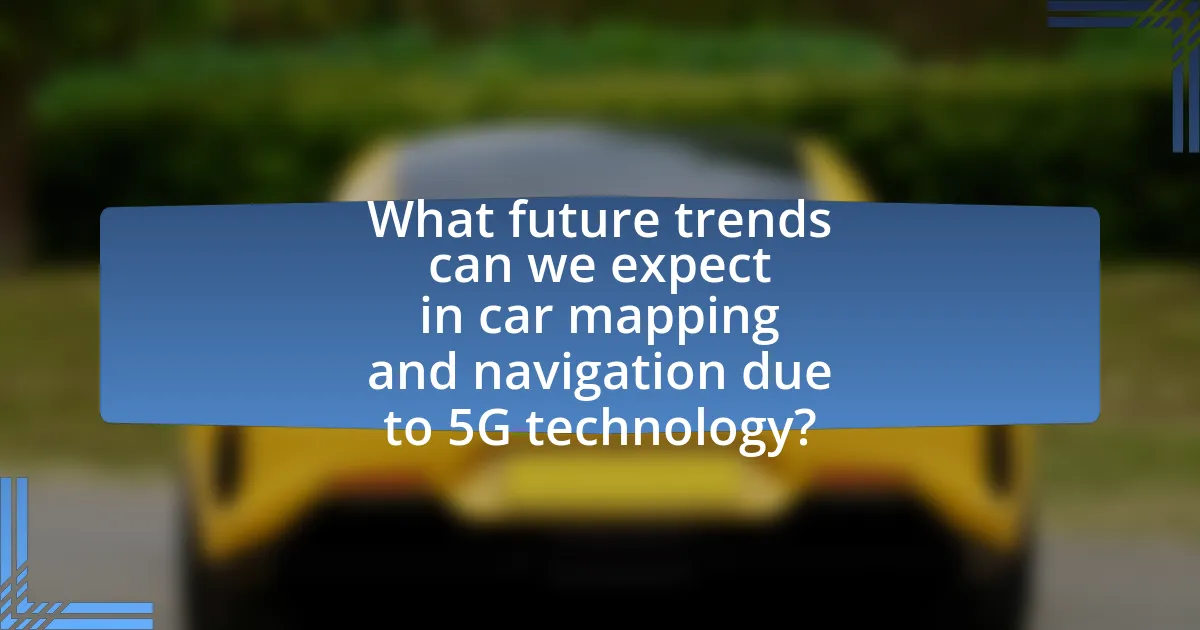
What future trends can we expect in car mapping and navigation due to 5G technology?
Future trends in car mapping and navigation due to 5G technology include enhanced real-time data processing, improved accuracy in location services, and the integration of advanced features like augmented reality. 5G’s high-speed connectivity and low latency enable vehicles to access and process vast amounts of data from various sources, such as traffic conditions and weather updates, in real-time. This capability allows for more precise navigation and route optimization, significantly reducing travel time. Additionally, the ability to support vehicle-to-everything (V2X) communication will facilitate safer driving by allowing cars to communicate with each other and infrastructure, further enhancing navigation systems. These advancements are supported by the expected rollout of 5G networks, which are projected to cover a significant portion of urban areas by 2025, thus transforming the landscape of car mapping and navigation services.
How will 5G shape the evolution of smart cities and transportation systems?
5G will significantly enhance the evolution of smart cities and transportation systems by providing ultra-reliable low-latency communication, enabling real-time data exchange and improved connectivity. This advancement allows for the integration of Internet of Things (IoT) devices, which can optimize traffic management, reduce congestion, and enhance public safety through smart traffic signals and connected vehicles. For instance, a study by the GSMA indicates that 5G can support up to one million devices per square kilometer, facilitating the deployment of smart infrastructure. Additionally, 5G’s high-speed connectivity will enable advanced applications such as autonomous vehicles and smart public transport systems, which rely on instantaneous data processing to navigate efficiently and safely.
What innovations in navigation technology are anticipated with the widespread adoption of 5G?
The widespread adoption of 5G is anticipated to bring significant innovations in navigation technology, including enhanced real-time data processing, improved accuracy in location tracking, and the integration of advanced features such as augmented reality navigation. 5G’s low latency and high bandwidth will enable vehicles to communicate with each other and with infrastructure in real-time, facilitating safer and more efficient navigation. For instance, studies indicate that 5G can reduce latency to as low as 1 millisecond, which is crucial for applications requiring immediate feedback, such as collision avoidance systems. Additionally, the increased data capacity will support the use of high-definition maps and real-time traffic updates, allowing for dynamic route optimization.
How might user expectations change as 5G technology becomes standard in vehicles?
User expectations will likely shift towards demanding faster, more reliable connectivity and enhanced features as 5G technology becomes standard in vehicles. With 5G’s increased bandwidth and lower latency, users will anticipate real-time updates for navigation, improved traffic data accuracy, and seamless integration of advanced driver-assistance systems. For instance, studies indicate that 5G can support up to one million devices per square kilometer, enabling vehicles to communicate with each other and infrastructure more effectively, thus raising user expectations for safety and convenience in navigation services.
What best practices should users follow to maximize the benefits of 5G in navigation services?
To maximize the benefits of 5G in navigation services, users should ensure their devices are 5G-compatible and utilize applications specifically designed to leverage 5G’s high-speed connectivity. This compatibility allows for real-time data processing and enhanced location accuracy, which are crucial for effective navigation. Additionally, users should regularly update their navigation apps to access the latest features and improvements that take advantage of 5G technology. Research indicates that 5G can reduce latency to as low as 1 millisecond, significantly improving the responsiveness of navigation services. By following these practices, users can fully exploit the advantages of 5G for more efficient and reliable navigation.
How can users ensure their devices are optimized for 5G connectivity?
Users can ensure their devices are optimized for 5G connectivity by updating their device software to the latest version, which often includes enhancements for 5G performance. Additionally, users should verify that their device supports 5G bands used by their carrier, as compatibility is crucial for accessing 5G networks. According to the GSMA, as of 2023, over 1.5 billion 5G devices have been shipped globally, indicating a significant push towards 5G compatibility in modern devices. Furthermore, users should enable 5G settings in their device’s network options to ensure they are connected to the fastest available network.
What tips can enhance the overall navigation experience with 5G technology?
To enhance the overall navigation experience with 5G technology, users should utilize real-time data integration for traffic updates and route optimization. This approach leverages 5G’s low latency and high bandwidth capabilities, allowing for instantaneous communication between vehicles and infrastructure. For instance, studies indicate that 5G can reduce latency to as low as 1 millisecond, significantly improving the responsiveness of navigation systems. Additionally, incorporating augmented reality features can provide drivers with enhanced situational awareness, as 5G supports high-definition video streaming and interactive content. By utilizing these advanced features, drivers can experience more accurate and efficient navigation, ultimately leading to safer and more enjoyable journeys.
